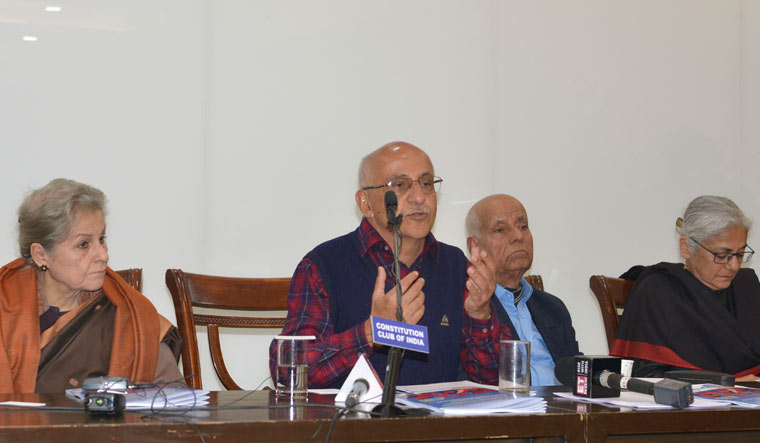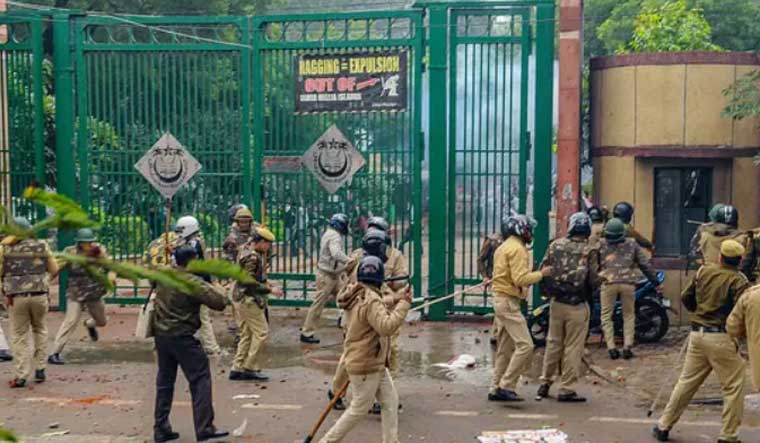Students of Aligarh Muslim University claimed that the police raised slogans of 'Jai Shri Ram' as they stormed the campus and attacked them brutally, according to a report released by a fact-finding team of Karwan-E-Mohabbat and Indian Cultural Forum, who visited the campus on December 17.
The report titled “The Siege of Aligarh Muslim University’’ was released at the Constitutional Club in the capital on Tuesday. It said that the students were too scared to lodge complaints against the police.
Many students, the team found, had been “warned by the university authorities that if any student filed a complaint, he would be expelled… and criminal charges, even the under the dreaded National Security Act, would be lodged against them”, the report said.
The atmosphere of fear was such that even injured students did not go to treat their injuries. “The doctors told us that students who came with injuries, would have their names recorded. Many students never came to the hospitals,’’ said human rights activist Harsh Mander, who led the team. Delhi University teacher Nalini Sundar, lawyer Ankita Ramgopal and photographer Sandeep Yadav were some of the other members of the team.
 Harsh Mander, director of the Centre for Equity Studies, speaks during the release of the 'The Siege of Aligarh Muslim University' at a press conference in New Delhi | Arvind Jain
Harsh Mander, director of the Centre for Equity Studies, speaks during the release of the 'The Siege of Aligarh Muslim University' at a press conference in New Delhi | Arvind Jain
ALSO READ: OPINION: Students' protests against Citizenship Act herald coming revolution
As doctors from AMU's Jawaharlal Nehru Medical College started getting calls for help from the students, they sent 19 ambulances, the report noted. “At the time, the doctors at the hospital received instructions from the proctor that university ambulances should not be sent out to aid the students. As a result, only three of the 19 ambulances arranged were from the AMU; the rest were private ambulances,” the report read.
The team met around around 100 people in the university—from faculty, students, doctors to several university administrators. “The most contested question is whether there was violence by the students or whether it (the police action) was unprovoked. It was hard to come to a conclusion,’’ said Mander. “My answer is that even if there was violence, what the police did was disproportionate. Even if there was stone throwing, none of that justifies the scale of violence by the police.”
ALSO READ: Up in arms: A night of anger in universities as student protests rage across the country
Based on the testimony of the students and teachers, video footage, opinions of doctors and the “remarks’’ made by the administration, the team found that teargas shells, sound bombs, rubber bullets, stun guns and lathis were used on the students. “Doctors have confirmed that the blunt force trauma and resultant brain haemorrhage of a student indicate the use of rubber bullets,’’ the report said. Stun grenades are usually used in war situations.
The admission of use of stun gun was allegedly made by the registrar of the university, claims activist John Dayal. “When we asked him what kind of weapon was used, he said it was a stun gun. We repeatedly asked him,’’ he said.
“When the RAF entered Morrison Court hostel and when they were destroying vehicles on campus, they were heard shouting slogans such as “Bharat Mata ji Jai” and “Jai Shri Ram”. They also continued to call the students in the hostels ‘aatankvaadi’ (terrorists), the report said.
“The nature of violence that was let loose on the students is extremely disturbing and has left many of them with shattered bones, grave injuries, deep bruises and severe psychological trauma,” the report found. While the report documents the apathy of the university administration that washed its hands off the students, it also documents the level of brutality that the police subjected the students to.


